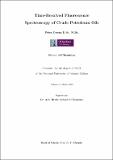| dc.contributor.advisor | Ryder, Alan G. | |
| dc.contributor.author | Owens, Peter | |
| dc.date.accessioned | 2012-11-20T09:44:07Z | |
| dc.date.available | 2012-11-20T09:44:07Z | |
| dc.date.issued | 2009-03 | |
| dc.identifier.uri | http://hdl.handle.net/10379/3065 | |
| dc.description.abstract | Characterisation of crude oil properties in real-time by spectroscopic methods has
been a major challenge to the oil industry. While current methods can show the
presence of oil, a quantitative determination of oil physical and chemical properties
has yet to be found. Also the mechanisms of oil photophysics are far from being fully
understood. This thesis seeks to address these issues by two principle objectives.
First, the determination of fluorescence lifetimes for crude oils by the Frequency
Domain method and second, the analysis of the eff ects of dilution and temperature
on the photophysical properties of crude oils. As a primary objective, a Frequency Domain (FD) method was developed to measure the fluorescence lifetimes of a series of crude oils. Analysis of the average lifetimes was made based on how many decay terms and the type of tting model used. Correlations were made between the bulk chemical data for the oils and average lifetimes from distribution and discrete models. The FD method was then applied to the analysis of Hydrocarbon Fluid Inclusions (HCFI) where individual inclusions could be isolated and the average lifetime determined for the included oils. Comparisons were made between the lifetimes for the bulk oils and HCFI. The second objective of the thesis was to examine the e ects of dilution and temperature on the photophysical behaviour of crude petroleum oils. Comparisons were made between lifetimes over the range of temperatures sampled and di fferences between dilute and neat average lifetime values gave estimations of quenching eff ects.
Lifetimes were monitored over a range of temperatures and were found to follow a
simple Arrhenius-like behaviour. A modi ed Stern-Volmer quenching model could
be applied to the crude oil lifetime data showing the presence of both static and
dynamic quenching and the calculated quenching rate constants have been found
to vary linearly with oil type. Neat and dilute oils also followed a reverse Eyring behaviour allowing calculation of activation enthalpy and entropy values. Although
the theory for the Arrhenius, Eyring and Stern-Volmer models is based on single fluorophore systems, they were found to apply for a complex system of multiple
emitting and interacting fluorophores. In the context of these simple models, the
average lifetime calculated for crude oils represented an summation of the excited
state processes. | en_US |
| dc.rights | Attribution-NonCommercial-NoDerivs 3.0 Ireland | |
| dc.rights.uri | https://creativecommons.org/licenses/by-nc-nd/3.0/ie/ | |
| dc.subject | Crude oils | en_US |
| dc.subject | Fluorescence lifetime | en_US |
| dc.subject | Chemistry | en_US |
| dc.title | Time-Resolved Fluorescence Spectroscopy of Crude Petroleum Oils | en_US |
| dc.type | Thesis | en_US |
| dc.contributor.funder | SFI | en_US |
| dc.local.note | Characterisation of crude oil properties by spectroscopic methods is highly desirable to the oil industry, yet remains a challenge to obtain methods that are robust and quantitative. While current methods can show the presence of oil, quantitative determination of physical and chemical properties has yet to be found. In this thesis we provide observations of fluorescence lifetime taken at various conditions, in an effort to obtain a quantitative model for crude oil prediction. | en_US |
| dc.local.final | Yes | en_US |
| nui.item.downloads | 2633 | |


